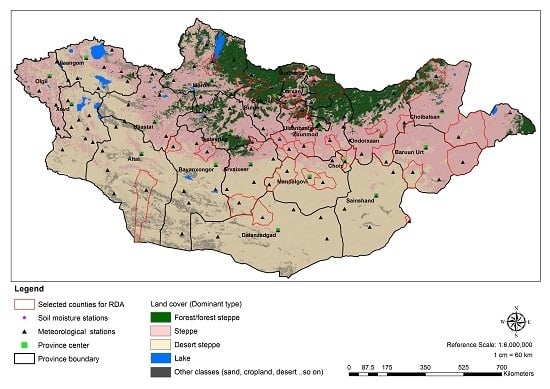Suitability Assessment of Satellite-Derived Drought Indices for Mongolian Grassland
Abstract
:1. Introduction
2. Study Region and Data
2.1. Study Region
2.2. Data
2.2.1. Station Data
2.2.2. Region Drought-Affected Data
2.2.3. RS Data
2.2.4. Base Data
3. Methodology
3.1. Satellite-Derived Indices
3.1.1. Pixel Levels
3.1.2. County Level
3.2. Ground Data-Derived Indices
3.2.1. Station Level
3.2.2. County Level
3.3. Suitability Analysis
3.3.1. Correlation
3.3.2. Consistence Percentage
3.3.3. Spatial Analysis
4. Results
4.1. Comparisons with the PED
4.2. Comparisons with Soil Moisture
4.3. Comparisons with the NorBio
4.4. Comparisons with the RDA in County
4.5. Spatial Consistence Comparsions
4.6. Comprehensive Results
5. Discussion
6. Conclusions
Acknowledgments
Author Contributions
Conflicts of Interest
References
- Bayarjargal, Y.; Karnieli, A.; Bayasgalan, M.; Khudulmur, S.; Gandush, C.; Tucker, C.J. A comparative study of NOAA–AVHRR derived drought indices using change vector analysis. Remote Sens. Environ. 2006, 105, 9–22. [Google Scholar] [CrossRef]
- Natsagdorj, L. Climate Change. In Climate Change and Its Impacts on Mongolia; Batima, P., Dagvadorj, D., Eds.; JEMR Press: Ulaanbaatar, Mongolia, 2000; pp. 14–43. [Google Scholar]
- Batima, P.; Dagvadorj, D. Climate Change Its Impacts in Mongolia; JEMR Publishing: Ulaanbaatar, Mongolia, 2000; pp. 97–199. [Google Scholar]
- Tucker, C.J. Red and photographic infrared linear combinations for monitoring vegetation. Remote Sens. Environ. 1979, 8, 127–150. [Google Scholar] [CrossRef]
- Ji, L.; Peters, A. Assessing vegetation response to drought in the northern Great Plains using vegetation and drought indices. Remote Sens. Environ. 2003, 87, 85–98. [Google Scholar] [CrossRef]
- Karnieli, A.; Agam, N.; Pinker, R.T.; Anderson, M.; Imhoff, M.L.; Gutman, G.G.; Panov, N.; Goldberg, A. Use of NDVI and land surface temperature for drought assessment: Merits and limitations. J. Clim. 2010, 23, 618–633. [Google Scholar] [CrossRef]
- Kogan, F.N. Application of Vegetation Index and Brightness Temperature for Drought Detection. Adv. Space Res. 1995, 15, 91–100. [Google Scholar] [CrossRef]
- Ceccato, P.; Flasse, S.; Gre’goire, J. Designing a spectral index to estimate vegetation water content from remote sensing data Part 2. Validation and applications. Remote Sens. Environ. 2002, 82, 198–207. [Google Scholar] [CrossRef]
- Zhang, N.; Hong, Y.; Qin, Q.; Liu, L. VSDI: A visible and shortwave infrared drought index for monitoring soil and vegetation moisture based on optical remote sensing. Int. J. Remote Sens. 2013, 34, 4585–4609. [Google Scholar] [CrossRef]
- Gao, B.C. NDWI-A Normalized Difference Water Index for remote sensing of vegetation liquid water from space. Remote Sens. Environ. 1996, 58, 257–266. [Google Scholar] [CrossRef]
- Wang, L.; Qu, J.J. NMDI: A normalized multi-band drought index for monitoring soil and vegetation moisture with satellite remote sensing. Geophys. Res. Lett. 2007, 34, 117–131. [Google Scholar] [CrossRef]
- Maki, M.; Ishiahra, M.; Tamura, M. Estimation of leaf water status to monitor the risk of forest fires by using remotely sensed data. Remote Sens. Environ. 2004, 90, 441–450. [Google Scholar] [CrossRef]
- Gu, Y.; Brown, J.F.; Verdin, J.P.; Wardlow, B. A five-year analysis of MODIS NDVI and NDWI for grassland drought assessment over the central Great Plains of the United States. Geophys. Res. Lett. 2007, 34, L06407. [Google Scholar] [CrossRef]
- Gutman, C.G. Towards drought monitoring from space. J. Clim. 1990, 3, 282–295. [Google Scholar] [CrossRef]
- Carlson, T.N.; Perry, E.M.; Schmugge, T.J. Remote estimation of soil moisture availability and fractional vegetation cover for agricultural fields. Agric. For. Meteorol. 1990, 52, 45–69. [Google Scholar] [CrossRef]
- McVicar, T.R.; Bierwirth, P.N. Rapidly assessing the 1997 drought in Papua New Guinea using composite AVHRR imagery. Int. J. Remote Sens. 2001, 22, 2109–2128. [Google Scholar] [CrossRef]
- Sandholt, I.; Rasmussen, K.; Anderson, J. A simple interpretation of the surface temperature/vegetation index space for assessment of the surface moisture status. Remote Sens. Environ. 2002, 79, 213–224. [Google Scholar] [CrossRef]
- Wang, P.-X.; Li, X.-W.; Gong, J.-Y.; Song, C.-H. Vegetation temperature condition index and its application for drought monitoring. In Proceedings of the International Geoscience and Remote Sensing Symposium, Sydney, Australia, 9–14 July 2001; pp. 141–143. [Google Scholar]
- Kogan, F.N.; Stark, R.; Gitelson, A.; Jargalsaikhan, L.; Dugrajav, C.; Tsooj, S. Derivation of pasture biomass in Mongolia from AVHRR-based vegetation health indices. Int. J. Remote Sens. 2004, 25, 2889–2896. [Google Scholar] [CrossRef]
- Dorjsuren, M.; Liou, Y.; Cheng, C. Time series and in-situ data analysis for Mongolia drought. Remote Sens. 2016, 8, 509. [Google Scholar] [CrossRef]
- Price, J.C. Thermal inertia mapping: A new view of the earth. Geophys. Res. 1977, 82, 25–82. [Google Scholar] [CrossRef]
- Idso, S.B.; Jackson, R.D.; Pinter, P.J.J. Normalizing the stress degree day for environmental variability. Agric. Meteorol. 1981, 24, 45–55. [Google Scholar] [CrossRef]
- Li, F.; Chen, W.; Zeng, Y.; Zhao, Q.; Wu, B. Improving Estimates of Grassland Fractional Vegetation Cover Based on a Pixel Dichotomy Model: A Case Study in Inner Mongolia, China. Remote Sens. 2014, 6, 4705–4722. [Google Scholar] [CrossRef]
- Ackerman, S.; Strablal, K.; Menzel, P.; Frey, R.; Moeller, C.; Gumley, L.; Baum, B.; Seeman, S.W.; Zhang, H. Discriminating Clear-Sky from Cloud with MODIS Algorithm Theoretical Basis Document (Mod35), 4th ed.; Goddard Space Flight Center: Greenbelt, MD, USA, 2002.
- Kaufman, Y.J.; Wald, A.E.; Remer, L.A. The MODIS 2.1 mm channel correlation with visible reflectance for use in remote sensing of aerosol. IEEE Trans. Geosci. Remote Sens. 1997, 35, 1286–1298. [Google Scholar] [CrossRef]
- Vermote, E.F.; Tanre, D.; Deuze, J.J. Second simulation of the satellite signal in the solar spectrum: An overview. IEEE Trans. Geosci. Remote Sens. 1997, 35, 675–686. [Google Scholar] [CrossRef]
- Jiang, L.P.; Qin, Z.H.; Xie, W. Program splits window algorithm to retrieve land surface temperature for MODIS data using IDL. Geomat. Spat. Inf. Technol. 2006, 29, 114–117. [Google Scholar]
- Khudulmur, S.; Elbegjargal, N.; Tsogtbaatar, J.; Dash, D.; Mandakh, N. Desertification Atlas of Mongolia; Institute of Geoecology, Mongolian Academy of Sciences: Ulaanbaatar, Mongolia, 2014; pp. 38–41. [Google Scholar]
- Ped, D.A. On indicators of droughts and wet conditions (in Russian). Proc. USSR Hydrometeorol. Cent. 1975, 156, 19–39. [Google Scholar]
- Zhang, W.; Qing, Z.; Lin, L. Quantitative analysis of the impact of agricultural drought on national food securit. J. Nat. Disasters 2010, 19, 111–118. (In Chinese) [Google Scholar]
- Natsagdorj, L.; Bayasgalan, G.; Gomboluudev, P. The Issue of Present Climate Change over Mongolia. MAS Inf. 2005, 178, 23–44. [Google Scholar]
- Dagvadorj, D.; Natsagdorj, L.; Dorjpurev, J.; Namkhainyam, B. Nature and Tourism; Mongolia Assessment Report on Climate Change; Ministry of Environment: Ulaanbaatar, Mongolia, 2009.
- Koleva, E.; Alexandrov, V. Drought in the Bulgarian low regions during the 20th century. Theor. Appl. Climatol. 2008, 92, 113–120. [Google Scholar] [CrossRef]
- Day, W.; Legg, B.J.; Johnston, A.E.; Lawlor, D.W.; Jeffers, W.; De, C. A drought experiment using mobile shelters: The effect of drought on barley yield, water use and nutrient uptake. J. Agric. Sci. 1978, 91, 599–623. [Google Scholar] [CrossRef]
- Jamieson, P.D.; Martin, R.J.; Francis, G.S.; Wilson, D.R. Drought effects on biomass production and radiation-use efficiency in barley. Field Crops Res. 1995, 43, 77–86. [Google Scholar] [CrossRef]
- Xia, Y.; Sheffield, J.; Ek, M.B.; Dong, J.; Chaney, N.; Wei, H.; Meng, J.; Wood, E.F. Evaluation of multi-model simulated soil moisture in NLDAS-2. J. Hydrol. 2014, 512, 107–125. [Google Scholar] [CrossRef]
- Yu, T.; Tian, G. The change of soil surface moisture by thermal inertia method. J. Remote Sens. 1997, 1, 24–31. [Google Scholar]
- National Remote Sensing Center & Environmental Information Center of IRIMHE in Mongolia. Available online: http://www.icc.mn/index.php?content=58 (accessed on 14 February 2017).
- Kogan, F.N. Operational space technology for global vegetation assessment. Bull. Am. Meteorol. Soc. 2001, 82, 1949–1964. [Google Scholar] [CrossRef]
- Kogan, F.N. World Droughts in the new millennium from AVHRR-based vegetation health indices. Eos Trans. Am. Geophys. Union 2002, 83, 557–564. [Google Scholar] [CrossRef]
- Kogan, F.; Gitelson, A.; Zakarin, E.; Spivak, L.; Lebed, L. AVHRR-based spectral vegetation indices for quantitative assessment of vegetation state and productivity: Calibration and validation. Photogramm. Eng. Remote Sens. 2003, 69, 899–906. [Google Scholar] [CrossRef]
- Mou, L. Drought Monitoring Based on the Remote Sensing Data; Institute of Remote Sensing Applications Chinese, Academy of Sciences: Beijing, China, 2006. [Google Scholar]
- Yan, N. Drought Monitoring Based on the Remote Sensed Indices; Institute of Remote Sensing Applications Chinese, Academy of Sciences: Beijing, China, 2005. [Google Scholar]
- Yan, N.N.; Wu, B.F.; Boken, V.J.; Chang, S.; Yang, L.D. A drought monitoring operational system for China using satellite data design and evaluation. Geomat. Nat. Hazards Risk 2014. [Google Scholar] [CrossRef]
- Jackson, J.T.; Chen, D.; Cosh, M.; Li, F.; Anderson, M.; Walthall, C.; Doriaswamy, P.; Hunt, E.R. Vegetation water content mapping using Landsat data derived normalized difference water index for corn and soybeans. Remote Sens. Environ. 2004, 92, 475–482. [Google Scholar] [CrossRef]
- Chen, D.; Huang, J.; Jackson, T.J. Vegetation water content estimation for corn and soybeans using spectral indices derived from MODIS near- and short-wave infrared bands. Remote Sens. Environ. 2005, 98, 225–236. [Google Scholar] [CrossRef]
- Brubaker, K.L.; Entekhabi, D. Analysis of feedback mechanisms in land-atmosphere interaction. Water Resour. Res. 1996, 5, 1343–1357. [Google Scholar] [CrossRef]
- Karnieli, A.; Bayasgalan, M.; Bayarjargal, Y.; Agam, N.; Khudulmur, S.; Tucker, C.J. Comments on the use of the vegetation health index over Mongolia. Int. J. Remote Sens. 2006, 27, 2017–2024. [Google Scholar] [CrossRef]
- Lambin, E.F.; Ehrlich, D. The surface temperature-vegetation index space for land cover and land-cover change analysis. Int. J. Remote Sens. 1996, 17, 463–487. [Google Scholar] [CrossRef]
- Tateishi, R.; Ebata, M. Analysis of phonological change patterns using 1982–2000 Advanced Very High Resolution Radiometer (AVHRR) data. Int. J. Remote Sens. 2004, 25, 2287–2300. [Google Scholar] [CrossRef]
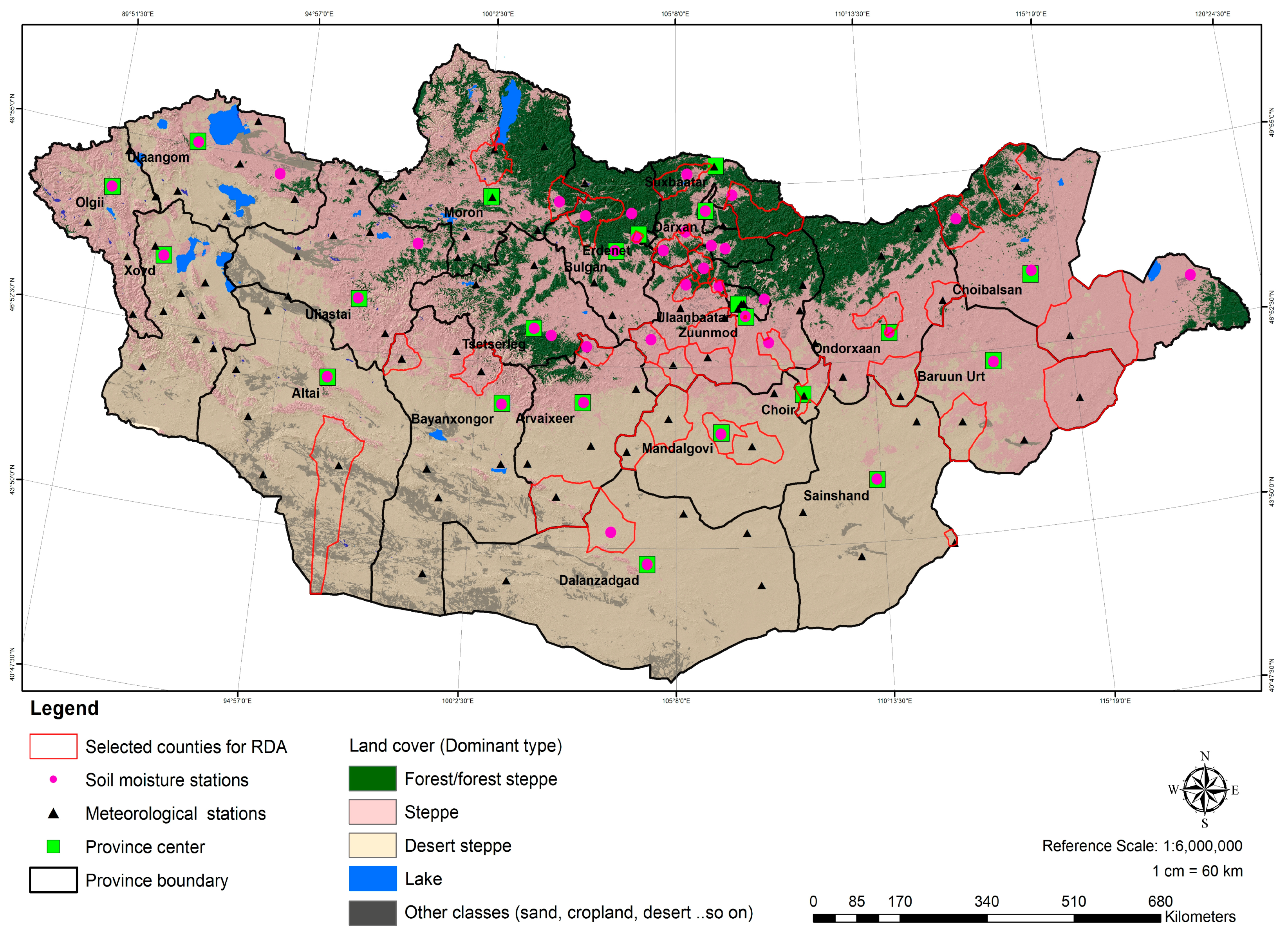
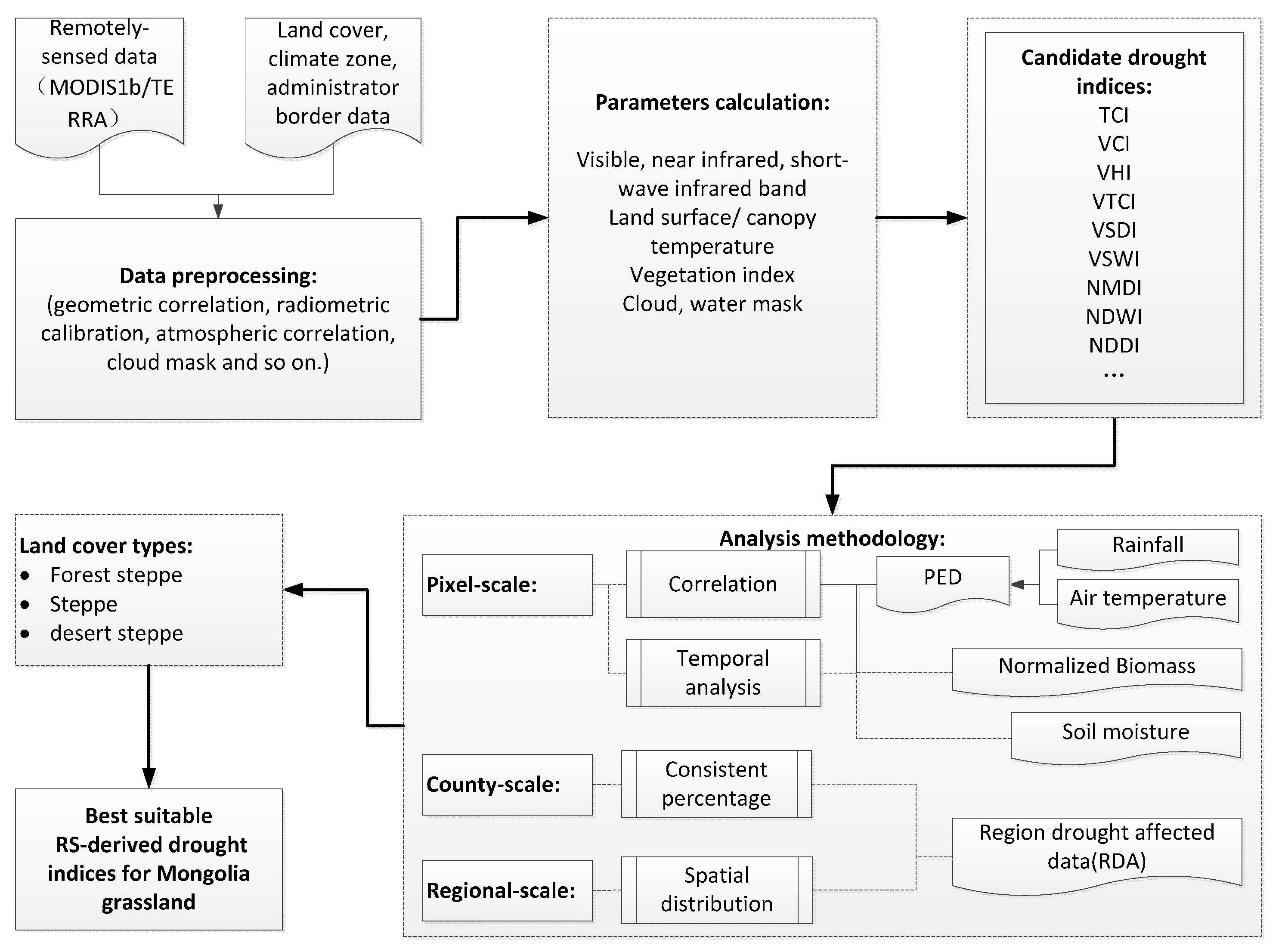
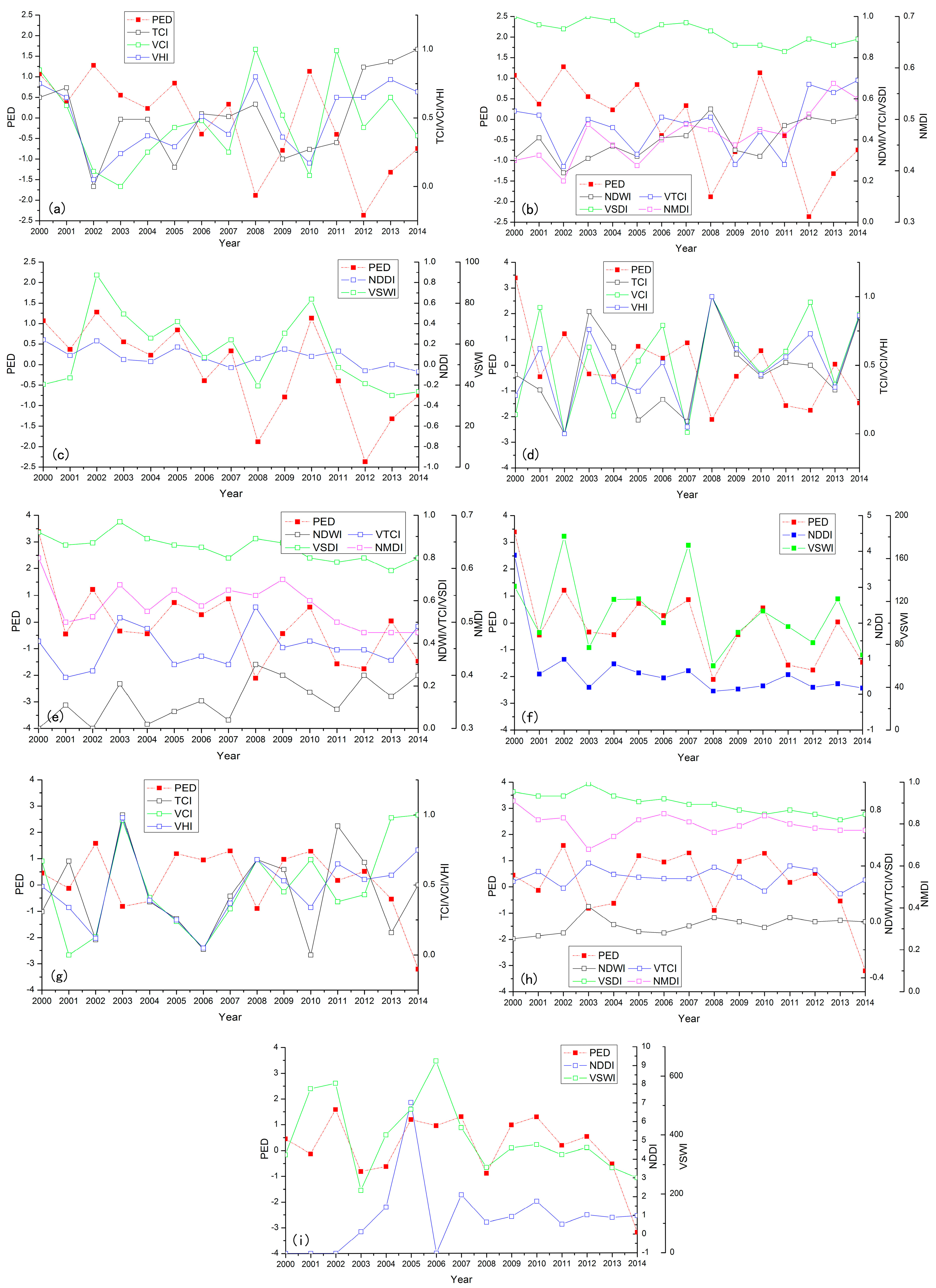
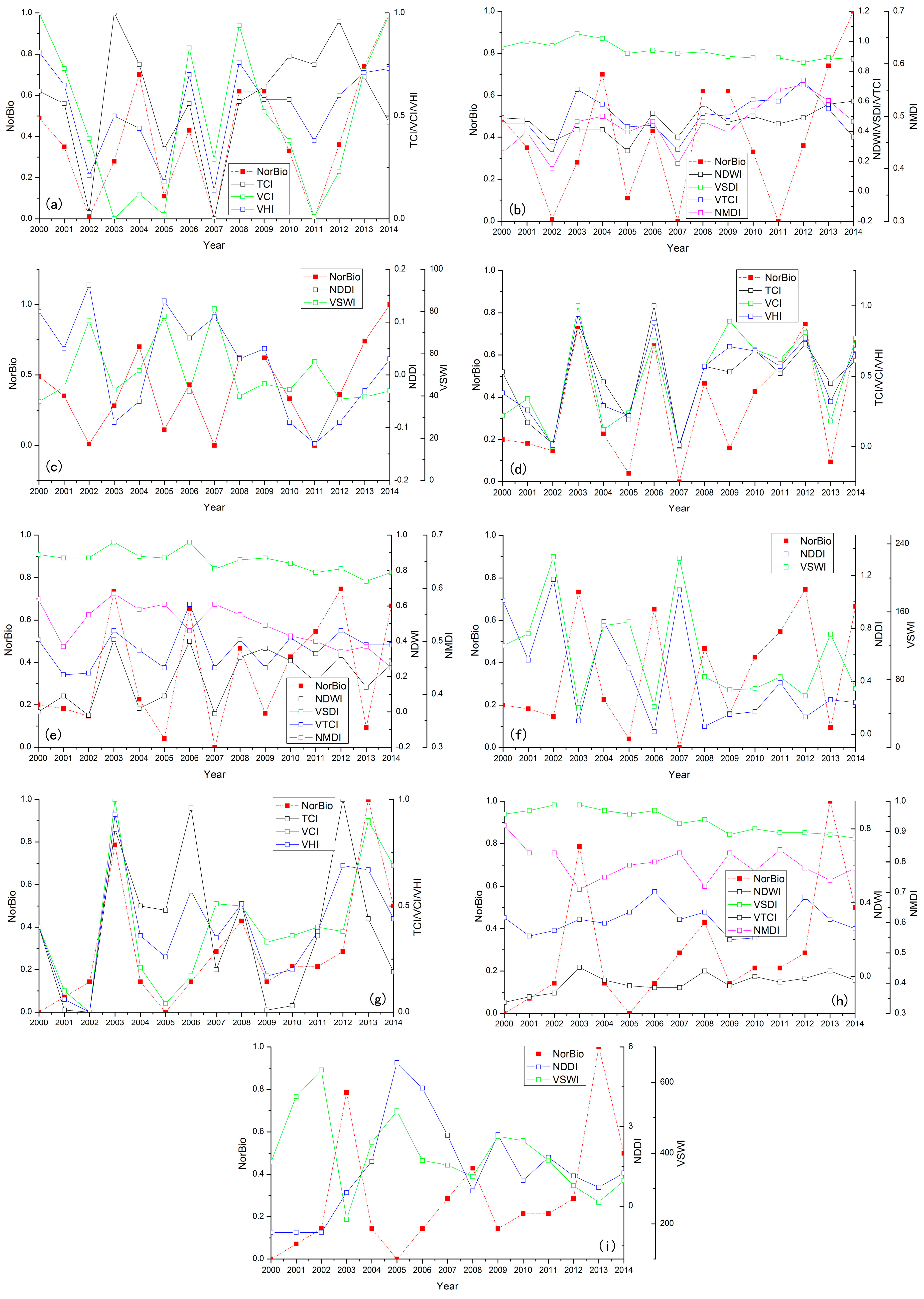
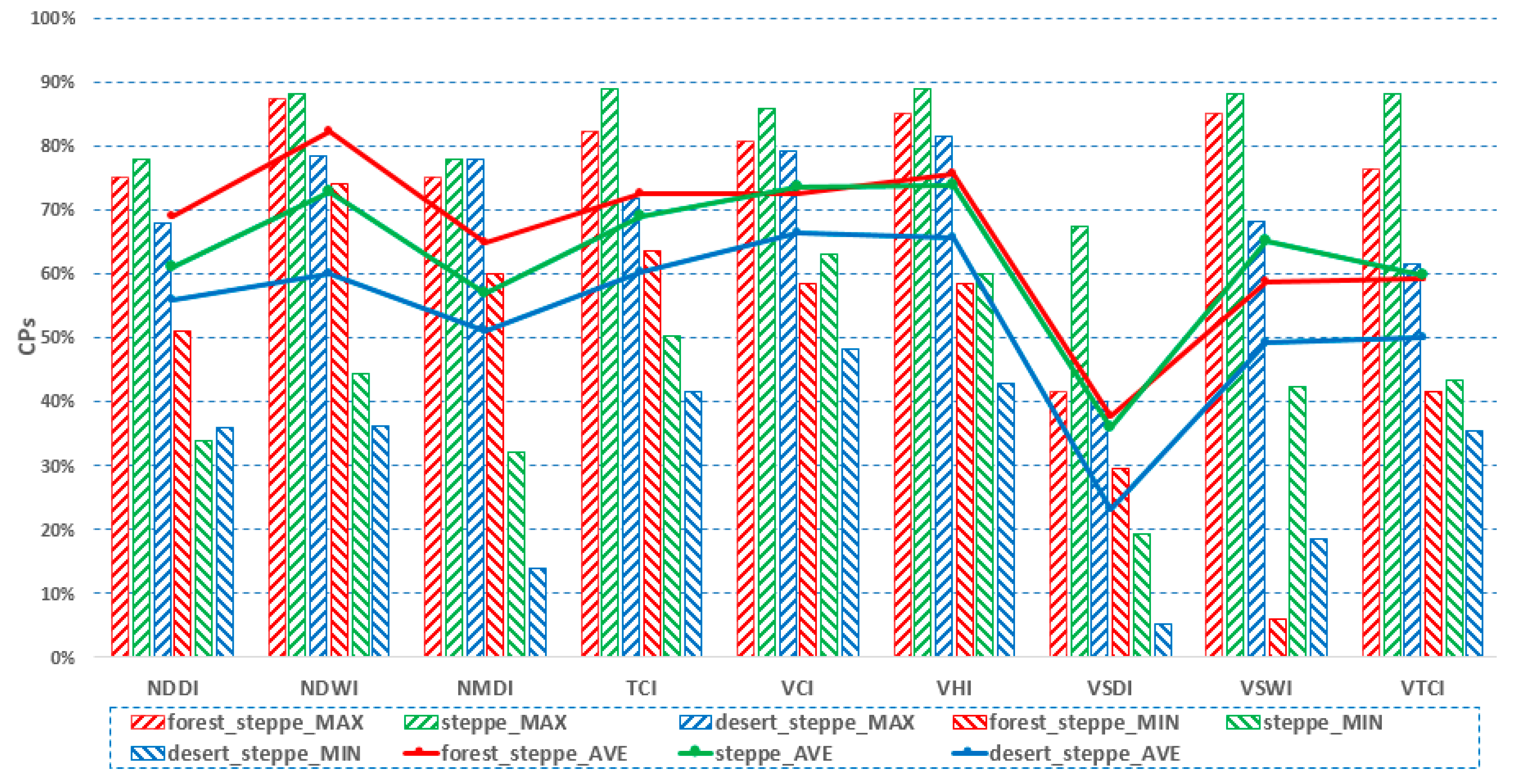
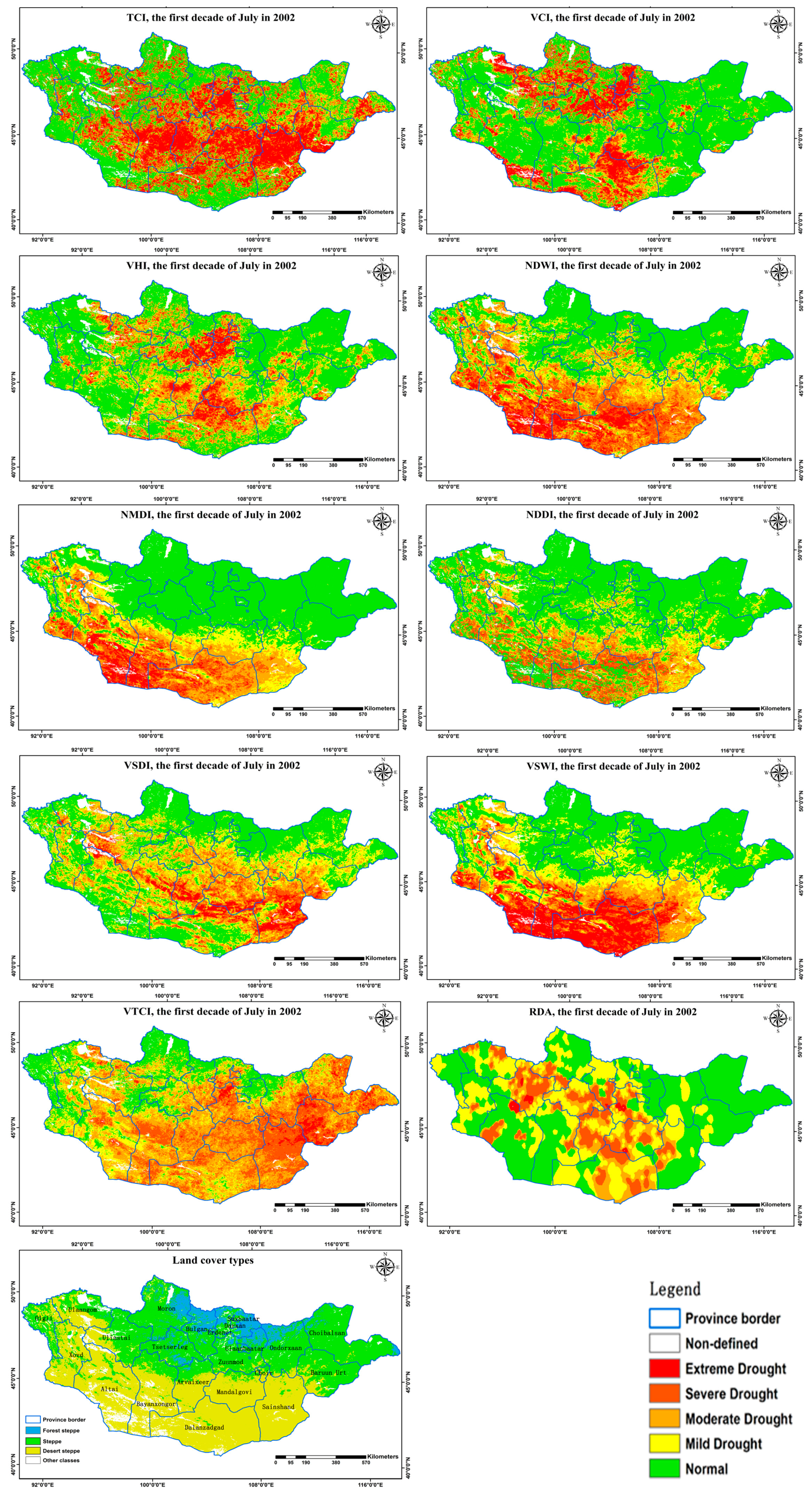
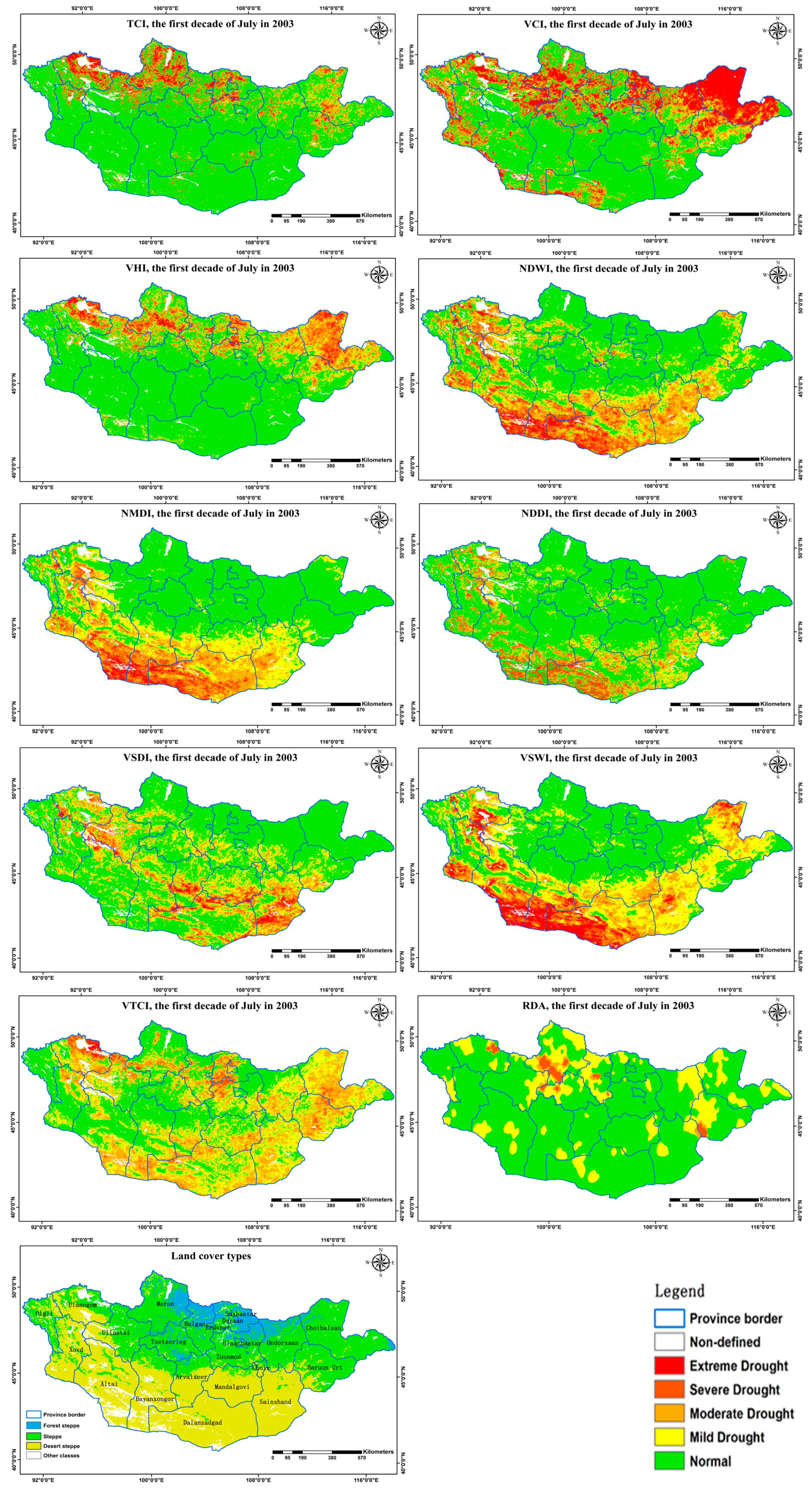
| Data Type | Year | Information | Source |
|---|---|---|---|
| Land cover | collected in 2010 | The NRSC of Mongolia | |
| Administrator boundary | from the IRIMHE of Mongolia | The NRSC of Mongolia | |
| MODIS 1B data (daily) | 2000–2014 | MODIS/TERRA | The Atmosphere Archive and Distribution System (LAADS) of National Aeronautics and Space Administration’s (NASA) |
| Precipitation (P) | 2000–2014 | 86 meteorological stations | The IRIMHE of Mongolia |
| Air temperature (T) | 2000–2014 | 86 meteorological stations | The IRIMHE of Mongolia |
| Soil moisture | 2000–2011 | 39 stations | The IRIMHE of Mongolia |
| Biomass | 2000–2014 | 86 meteorological stations | The IRIMHE of Mongolia |
| Drought-affected region (RDA) data | 2000–2014 | 37 counties with four directional values in each county | The IRIMHE of Mongolia |
| Satellite-Based Drought Index | Authors | Formula(e) |
|---|---|---|
| VCI | Kogan, F.N., 1995 [7] | NDVImax and NDVImin are the maximum and minimum NDVI in multi-year dataset |
| TCI | Kogan, F.N., 1995 [7] | LSTmax and LSTmin are the maximum and minimum LST in multi-year dataset |
| VHI | Kogan, F.N., 1995 [7] | |
| VTCI | Wang et al., 2001 [18] | |
| NMDI | Wang, L. and Qu, J.J., 2007 [11] | |
| VSDI | Zhang et al., 2013 [9] | |
| VSWI | Carlson et al., 1990 [15] | |
| NDWI | Gao, 1996 [10] | |
| NDDI | Yingxin Gu, 2007 [13] |
| RS-Derived Indices | Forest Steppe | Steppe | Desert Steppe |
|---|---|---|---|
| TCI | −0.69/−0.43/−0.57/0.07 | −0.71/−0.35/−0.56/0.08 | −0.62/−0.28/−0.46/0.09 |
| VCI | −0.57/−0.20/−0.34/0.14 | −0.68/−0.27/−0.47/0.10 | −0.58/−0.16/−0.40/0.11 |
| VHI | −0.75/−0.36/−0.61/0.09 | −0.76/−0.52/−0.66/0.07 | −0.75/−0.31/−0.56/0.11 |
| NDWI | −0.65/−0.20/−0.50/0.10 | −0.69/−0.29/−0.54/0.09 | −0.58/−0.20/−0.43/0.09 |
| NDDI | 0.58/0.21/0.44/0.10 | 0.62/0.02/0.39/0.15 | 0.39/−0.04/0.15/0.12 |
| VSWI | 0.70/0.35/0.54/0.09 | 0.73/0.35/0.58/0.10 | 0.64/0.33/0.48/0.09 |
| VTCI | −0.63/−0.29/−0.48/0.08 | −0.59/−0.23/−0.46/0.09 | −0.57/−0.22/−0.39/0.10 |
| VSDI | 0.48/0.02/0.25/0.11 | 0.35/−0.29/0.13/0.13 | −0.11/0.23/0.09/0.10 |
| NMDI | −0.59/0.05/−0.27/0.20 | 0.48/−0.52/0.10/0.24 | 0.51/0.13/0.31/0.13 |
| RS-Derived Indices | Forest Steppe | Steppe | Desert Steppe |
|---|---|---|---|
| TCI | 0.58/0.03/0.36/0.16 | 0.63/0.05/0.39/0.15 | 0.49/0.13/0.32/0.13 |
| VCI | 0.17/0.13/0.08/0.10 | 0.49/0.10/0.24/0.13 | 0.58/0.35/0.43/0.08 |
| VHI | 0.42/0.10/0.32/0.13 | 0.67/0.10/0.40/0.15 | 0.61/0.37/0.48/0.08 |
| NDWI | 0.29/0.06/0.17/0.13 | 0.69/0.02/0.26/0.17 | 0.43/0.08/0.22/0.34 |
| NDDI | −0.32/0.00/−0.18/0.10 | −0.62/−0.10/−0.19/0.17 | −0.19/0.00/−0.10/0.07 |
| VSWI | −0.37/0.00/−0.28/0.12 | −0.65/0.00/−0.38/0.14 | −0.58/−0.40/−0.48/0.07 |
| VTCI | 0.51/0.00/0.29/0.14 | 0.60/0.00/0.33/0.14 | 0.47/0.03/0.25/0.17 |
| VSDI | 0.32/0.01/0.11/0.17 | 0.43/0.03/0.25/0.16 | 0.54/0.02/0.19/0.27 |
| NMDI | −0.29/0.00/0.02/0.25 | −0.39/0.00/−0.06/0.16 | −0.49/0.00/−0.26/0.25 |
| RS-Derived Indices | Forest Steppe | Steppe | Desert Steppe |
|---|---|---|---|
| TCI | 0.70/0.04/0.43/0.19 | 0.80/0.09/0.45/0.21 | −0.46/0.73/0.23/0.30 |
| VCI | 0.83/0.35/0.64/0.16 | 0.94/0.12/0.57/0.16 | 0.92/0.28/0.67/0.15 |
| VHI | 0.87/0.30/0.62/0.17 | 0.94/0.38/0.60/0.14 | 0.82/0.32/0.59/0.16 |
| NDWI | 0.92/0.48/0.70/0.14 | 0.95/0.15/0.61/0.17 | 0.86/0.08/0.48/0.20 |
| NDDI | −0.81/0.14/−0.57/0.17 | −0.80/−0.08/−0.50/0.19 | −0.57/0.11/−0.33/0.17 |
| VSWI | −0.78/0.38/−0.59/0.14 | −0.88/−0.33/−0.59/0.14 | −0.83/−0.26/−0.60/0.12 |
| VTCI | 0.61/−0.21/0.32/0.22 | 0.72/−0.32/0.31/0.25 | 0.68/−0.76/0.05/0.34 |
| VSDI | 0.49/−0.48/−0.08/0.25 | 0.73/−0.56/0.02/0.33 | 0.82/−0.70/−0.05/0.38 |
| NMDI | 0.69/0.00/0.39/0.22 | −0.70/0.67/−0.16/0.38 | −0.79/0.05/−0.36/0.23 |
| Reference Indicators | Forest Steppe | Steppe | Desert Steppe |
|---|---|---|---|
| PED | VHI */TCI ** | VHI */TCI ** | VHI */VSWI ** |
| Soil moisture | TCI */VTCI ** | NDWI */VHI ** | VHI */VSWI ** |
| NorBio | NDWI */VHI ** | VHI */NDWI ** | VCI */VSWI ** |
| RDA | NDWI */VHI ** | VHI */VCI ** | VCI */VHI ** |
| RDA spatial distribution | NDWI */VHI ** | VHI */VCI ** | VHI */VCI ** |
© 2017 by the authors. Licensee MDPI, Basel, Switzerland. This article is an open access article distributed under the terms and conditions of the Creative Commons Attribution (CC BY) license (http://creativecommons.org/licenses/by/4.0/).
Share and Cite
Chang, S.; Wu, B.; Yan, N.; Davdai, B.; Nasanbat, E. Suitability Assessment of Satellite-Derived Drought Indices for Mongolian Grassland. Remote Sens. 2017, 9, 650. https://doi.org/10.3390/rs9070650
Chang S, Wu B, Yan N, Davdai B, Nasanbat E. Suitability Assessment of Satellite-Derived Drought Indices for Mongolian Grassland. Remote Sensing. 2017; 9(7):650. https://doi.org/10.3390/rs9070650
Chicago/Turabian StyleChang, Sheng, Bingfang Wu, Nana Yan, Bulgan Davdai, and Elbegjargal Nasanbat. 2017. "Suitability Assessment of Satellite-Derived Drought Indices for Mongolian Grassland" Remote Sensing 9, no. 7: 650. https://doi.org/10.3390/rs9070650






